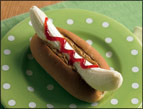B.S. Molecular Biology, Princeton University (graduated Cum Laude)
Continued education, New York University Medical School
Pediatric Residency training, Columbia Presbyterian’s Children’s Hospital, New York
Board-certified fellow, American Academy of Pediatrics
Maintains two private practices for child and adolescent weight management
Married to Doug, 2 children: Zachary, 7; Danielle, 4
What’s more fun than a “hot dog” for breakfast? Kids love this simple, tasty breakfast, and it’s easy to eat on the go.

MAKES 1 SERVING ■ EACH SERVING (1 BANANA DOG) = 2 GREENS
PREP TIME: 3 minutes
COOK TIME: None
READY TIME: 3 minutes
- 1 tablespoon peanut butter
- 1 light (preferably wheat) hot dog roll
- 1 banana
- 2 teaspoons sugar-free jelly
1. Spread the peanut butter on the hot dog roll.
2. Place the banana in the hot dog roll.
3. Spread the sugar-free jelly on the banana.
GUEST
Dr. Joanna Dolgoff: Red Light, Green Light, Eat Right
CBN.com
– SIMPLE ENOUGH FOR A 6-YEAR OLD
As a pediatrician, Dr. Dolgoff loved working with kids of all ages. After several years, she quickly grew frustrated at the number of overweight children she saw in her office. Most of her patients came in when they were sick or needed vaccinations. During these visits, Dr. Dolgoff stressed the importance of weight management for overall health to them.
“There were so many overweight kids and not enough time to help them,” she says. “I felt helpless about the situation.”
She started to research the subject of pediatric weight loss and discovered that no diet plan had ever been successful. “I wanted to develop a program that combined controlled calorie intake and healthy food choices,” says Dr. Dolgoff.
The program also needed to be simple enough for a 6-year-old to understand.
One day her daughter asked her how many calories were in her turkey sandwich. She explained to her daughter that the turkey sandwich on wheat bread was a healthy food. “In fact, it’s a 'green light' food,” she explained.
So Dr. Dolgoff began to use traffic light colors to help her daughter make better food choices, and ultimately she created Red Light, Green Light, Eat Right. Her program encourages nutritious eating habits and regular exercise as a family.
Soon, Dr. Dolgoff quit her job as a general pediatrician and decided to specialize in pediatric weight loss. She cautions putting a child on an adult diet. “The nutritional needs for a child are different than that of an adult,” she says. “Many adult diets are deprivational and are not meant for young children.” For example, low carb diets deprive kids of much-needed fruits and vegetables. Some side effects that may occur may include electrolyte imbalances, dehydration, low potassium levels, constipation due to inadequate fiber intake, and decreased intake of vitamin B. Children need carbs for energy.
Today in her weight management clinics Dr. Dolgoff screens overweight kids for possible medical problems and sees firsthand the effects that excess weight, obesity and poor diets have on today’s kids. She says the key to reversing the pediatric obesity problem in our country is parents. Many parents feel that the “baby fat” will melt away.
“The evidence overwhelmingly shows that heavy kids become heavy adults,” says Dr. Dolgoff. It is important for parents to act as soon as possible. By the time kids become teenagers, they often resist help from their parents.
RED LIGHT, GREEN LIGHT, GO!
Most Green Light foods contain protein, fiber and other nutrients. (The actual color does not always match the traffic light color.) Foods like fish, skinless chicken, fat-free hotdogs, potatoes, brown rice, whole-wheat bread and many types of cereals constitute Green Light foods. She also has “junky” Green Light foods, like 100-calorie pack chips and cookies. “They may not provide lots of nutrition, but in the right portions, they’re low in calories and will keep your kids from feeling deprived,” says Dr. Dolgoff.
Yellow Light foods are moderately high in calories and slighter higher in fat than Green Light foods. Yellow Light foods still provide healthy nutrition, but should be eaten in moderation. For example, olive oil, granola bars, dark chocolate and ice cream.
Red Light foods are treats that can be eaten twice a week. There are no off-limit foods in her program. Red Light foods are higher in calories, fat and sugar and don’t contain many nutritional benefits. For example, cake, pie, fried chicken, etc.
CBN IS HERE FOR YOU!
Are you seeking answers in life? Are you hurting?
Are you facing a difficult situation?
A caring friend will be there to pray with you in your time of need.
